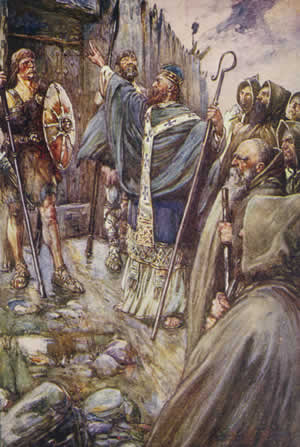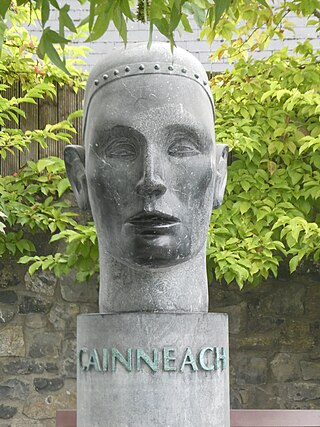
Columba or Colmcille was an Irish abbot and missionary evangelist credited with spreading Christianity in what is today Scotland at the start of the Hiberno-Scottish mission. He founded the important abbey on Iona, which became a dominant religious and political institution in the region for centuries. He is the patron saint of Derry. He was highly regarded by both the Gaels of Dál Riata and the Picts, and is remembered today as a Catholic saint and one of the Twelve Apostles of Ireland.

Skreen is a small village and parish in County Sligo, Ireland. The village is in a civil parish of the same name.

Cainnech of Aghaboe (515/16–600), also known as Saint Canice in Ireland, Saint Kenneth in Scotland, Saint Kenny and in Latin Sanctus Canicus, was an Irish abbot, monastic founder, priest and missionary during the early medieval period. Cainnech is one of the Twelve Apostles of Ireland and preached Christianity across Ireland and to the Picts in Scotland. He wrote a commentary on the Gospels, which for centuries was known as the Glas-Choinnigh or Kenneth's Lock or the Chain of Cainnech.

Finnian of Movilla was an Irish Christian missionary. His feast day is 10 September.
Lasrén (also Laisrén, Laisrán) mac Feradaig or Lasrén of Iona (d. 605) was an Irish monk and the third abbot of Iona (c.600-605), in succession to Baíthéne. Lasrén worked during the abbacy of St Columba and administered the monastery of Durrow for the saint in the years before attaining Iona. Like Baíthéne before him, he was a kinsman of Columba from the royal dynasty of the Cenél Conaill. His father, Feradach meaning 'woodsman', was a cousin of the saint.
Suibne moccu Fir Thrí [Suibne moccu Urthrí, Suibhne I] was the sixth abbot of Iona (652–657). His abbacy is obscure, and he appears not to have been from the same kindred, Cenél Conaill, as Columba and most other early Ionan abbots. His abbacy saw a continuation of the evangelization of England and spread of Gaelic churchmen there, with Diuma becoming the first Bishop of Mercia in 656. He died in 657 and his feast day is 11 January.
Cumméne Find was the seventh abbot of Iona (657–669), succeeding Suibne moccu Fir Thrí.
Adomnán or Adamnán of Iona, also known as Eunan, was an abbot of Iona Abbey (r. 679–704), hagiographer, statesman, canon jurist, and saint. He was the author of the Life of Columba, probably written between 697 and 700. This biography is by far the most important surviving work written in early-medieval Scotland, and is a vital source for our knowledge of the Picts, and an insight into the life of Iona and the early-medieval Gaelic monk.

The Cáin Adomnáin, also known as the Lex Innocentium, was promulgated amongst a gathering of Gaelic and Pictish notables at the Synod of Birr in 697. It is named after its initiator Adomnán of Iona, ninth Abbot of Iona after St. Columba. It is called the "Geneva Accords" of the ancient Irish and Europe's first human rights treaty, for its protection of women and non-combatants, extending the Law of Patrick, which protected monks, to civilians. The legal symposium at the Synod of Birr was prompted when Adomnáin had an Aisling dream vision wherein his mother excoriated him for not protecting the women and children of Ireland.
Colmán Elo was born in Glenelly, Ireland, in what is now County Tyrone. He is famed in Irish hagiography.

Hinba is an island in Scotland of uncertain location that was the site of a small monastery associated with the Columban church on Iona. Although a number of details are known about the monastery and its early superiors, and various anecdotes dating from the time of Columba of a mystical nature have survived, modern scholars are divided as to its whereabouts. The source of information about the island is Adomnán's late 7th-century Vita Columbae.
Forggus mac Muirchertaig, also called Forrgus mac Maic Ercae, is included in most lists of High Kings of Ireland.
The Life of Columba is a hagiography recounting the life of Columba, the founder of Iona Abbey, written a century after Columba's death by Adomnán, one of his successors as Abbot of Iona.
Baithéne mac Brénaind was an Irish monk, one of Saint Columba's followers who accompanied him to Scotland around 563, and was the first successor as Abbot of Iona Abbey. The Annals of Tigernach record his birth in 534, and his death was likely between 596 and 598 according also to the Annals of Ulster. Irish genealogical records indicate him to be the "son of Brendan, son of Fergus, son of Conall Gulban, son of Niall Noígiallach", thus being a member of the Cenél Conaill branch of the Northern Uí Néill, as the abbots of Iona Abbey following the death of Columba often were.
Beccán mac Luigdech was a 7th-century Irish composer of Christian poetry and monk of Iona. He is known for having composed two vernacular poems, Fo réir Choluimb and Tiugraind Beccáin, which were written c. 640 in praise of St Columba, the founder of Iona. Along with Amra Choluim Cille, the fragment of the Life of St Cumméne (Cummian) and Adomnán's Life of Columba, the poems offer a contemporary glimpse of the monastic familia of Iona in the 7th century. Beccán has been identified with the Beccán solitarius who along with Ségéne, abbot of Iona, was addressed in a letter written by Cumméne in c. 632–33 concerning the Easter controversy. He may also be the Beccán of Rùm, whose death is recorded in the entry for 677 in the Annals of Ulster.
Cruithnechán, also known as Cruithnechan, Crunathan, and Cronaghan, was an Irish saint from around the 6th century, known as one of the mentors of Columba, who founded the famous monastery at Iona.
Saints and animal/plant life. A number of Christian saints have anecdotes and stories about them in relation to animals or plants. In some cases they appeared to possess miraculous powers to speak with animals.
Broichan is the name of a wizard who lived in 6th century Pictland and served King Bridei I. Adomnán of Iona wrote about him and his relation to St Columba during the saint's travels in Pictland.
Cormac Ua Liatháin was a 6th-century Irish saint who is only known from Adomnan of Iona's Vita Columbae.
The plague of 664 was an epidemic that affected Great Britain and Ireland in 664 AD, during the first recorded plague pandemic. It was the first recorded epidemic in English history, and coincided with a solar eclipse. It was considered by later sources as "The Yellow Plague of 664" and said to have lasted for twenty or twenty-five years, causing widespread mortality, social disruption and abandonment of religious faith. The disease responsible was probably Plague – part of the First Plague Pandemic – or else smallpox.





